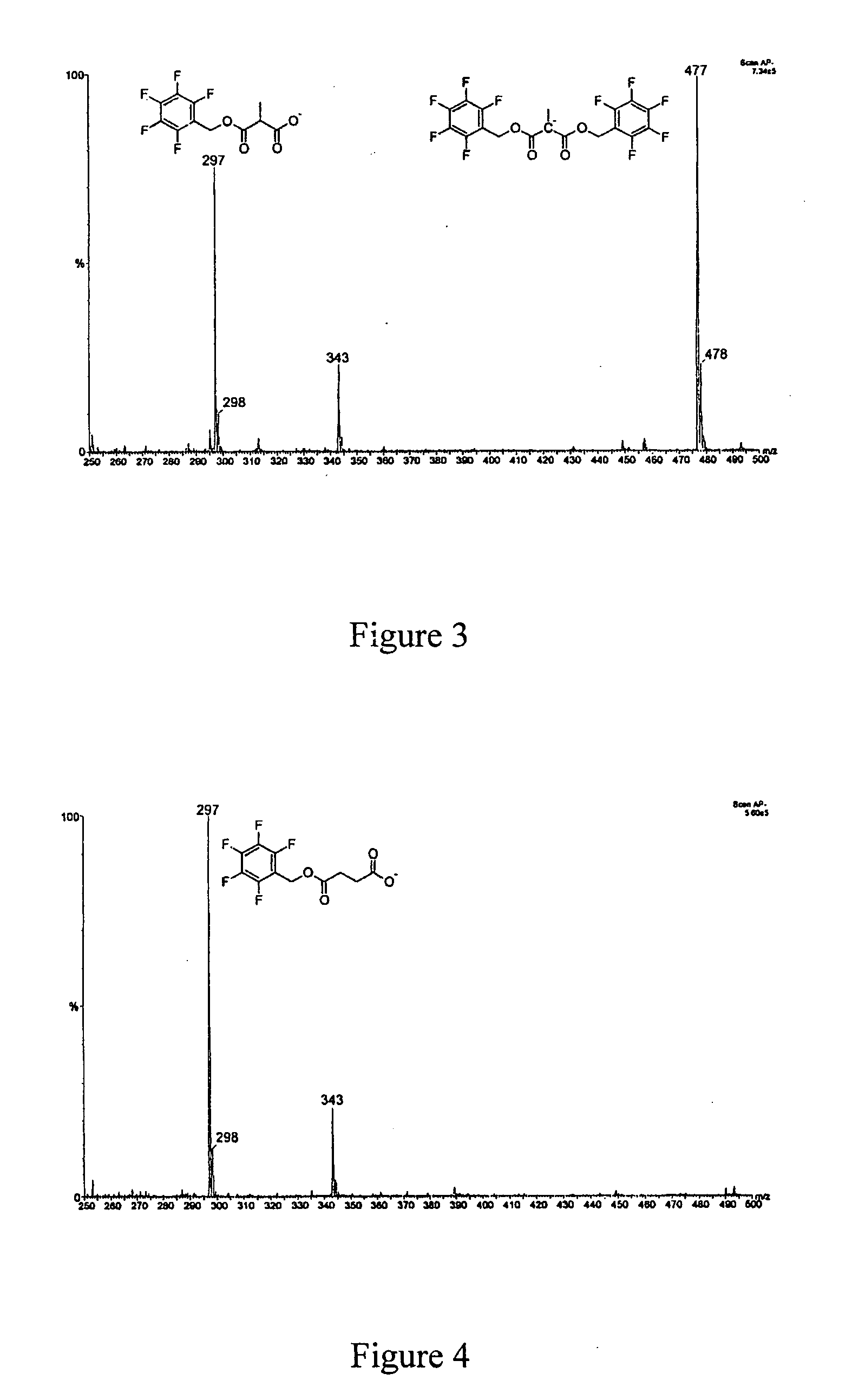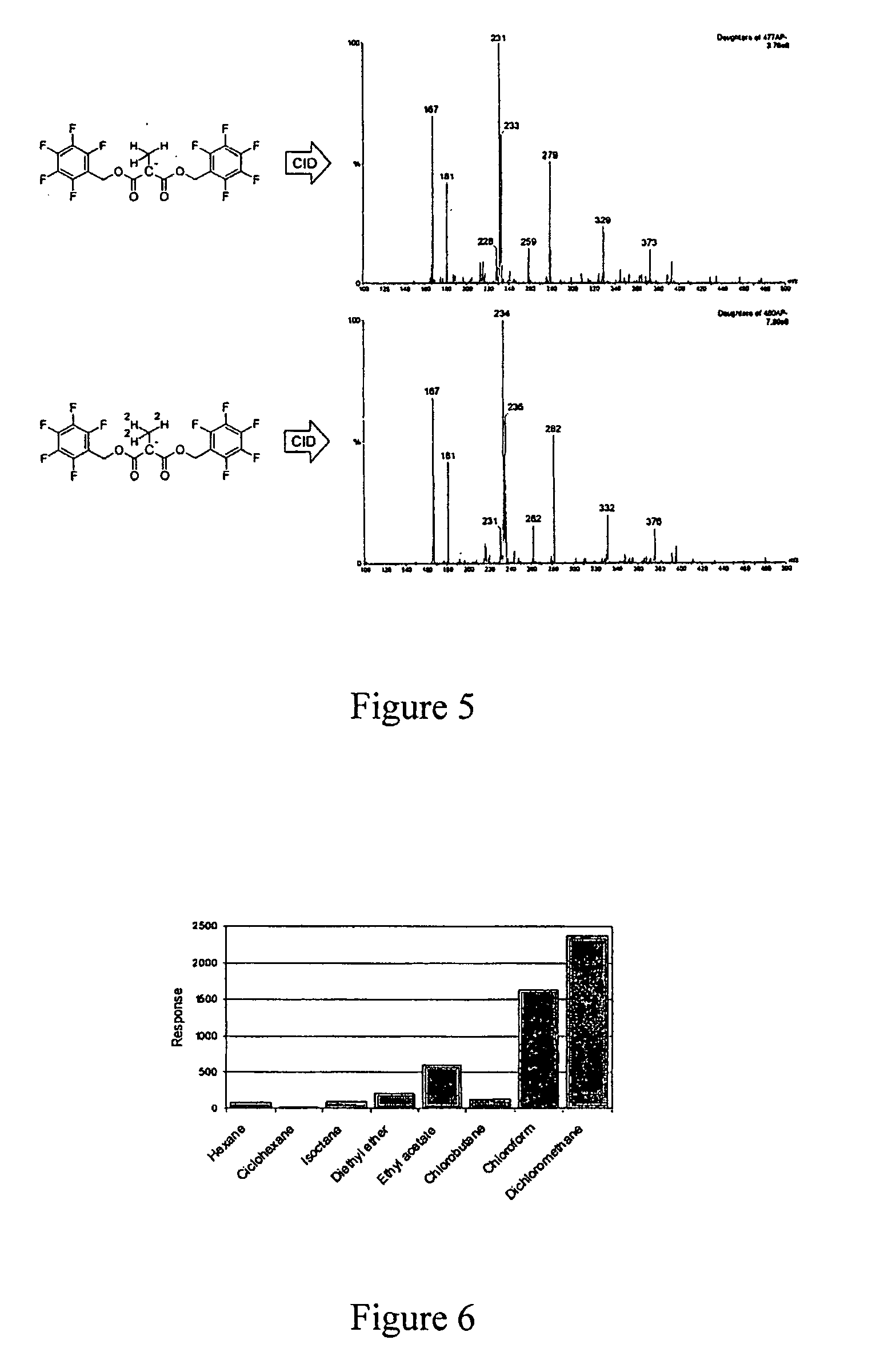Method for methylmalonic acid detemination based on alkylative extraction associated to liquid chromatography coupled to mass spectrometry
a technology of methylmalonic acid and alkylative extraction, which is applied in the direction of component separation, material testing goods, and withdrawal sample devices, etc., can solve the problems of increasing the excretion of mma, the inability to quantify mma widely, and the analysis of low molecular weight organic acids in biologic matrices is a very complex task
- Summary
- Abstract
- Description
- Claims
- Application Information
AI Technical Summary
Benefits of technology
Problems solved by technology
Method used
Image
Examples
example 1
Reagents
[0039]The illustrative examples of diagnosis kits and methodology of the present invention show as non-limiting way the following reagents that belong to the state of the art subject to be used: methylmalonic acid and 2,3,4,5,6-pentafluorobenzyl bromide optionally obtained from Fluka Chemie GmbH (Buchs, Switzerland); methyl-d3-malonic acid, from CDN Isotopes (Pointe-Claire, Canada); acetonitrile and dichloromethane, from Tedia (Fairfield, USA); triethylamine and dimethylsulfoxide, from Sigma Chemical CO (St. Louis, USA) and tetrabutylammonium hydrogen sulfate, from Vetec Química Fina Ltda (R10 de Janeiro, Brazil).
example 2
[0040]The analysis of illustrative examples shown below were carried out with LC-MS / MS system composed by a tandem mass spectrometer Quattro Micro (Water / Micromass, Manchester, United Kingdom) equipped with an atmospheric pressure chemical ionization probe operating at negative mode, a HP 1050 sampler (Agilent Palo Alto USA) and HPLC system Shimadzu with two LC-10Atvp pumps (Shimadzu, Kyoto, Japan). The data acquisition and control of all system components were performed by MassLynx 4.0 program (Water / Micromass, Manchester, United Kingdom).
[0041]Analysis by Direct Infusion on the Spectrometry Ionization Source
[0042]The analysis by mass spectrometry on scan mode (“full scan” and “daughter scan”) was performed through direct infusion of derivatives in acetonitrile / water (1:1) through a pump syringe integrated to the spectrometer. The spectrometer acquisition parameters such as ionization source voltages, probe and source temperatures, gas flow and collision energy were ...
example 3
Preparation of Solutions and Calibrators
[0045]Primary standard stock (S0)—1 mg / mL Methylmalonic Acid Solution (8.468 mmol / L)
[0046]10 mg of methylmalonic-d3 acid and add to a 100 mL-volumetric flask, a milli-Q water volume for 100 mL (concentration 0.847 mmol / L). Storage: −25° to −10° C. Validity: one month.
[0047]Secondary Stock Solutions (S1)
[0048]Dilute th primary stock solution (S0) preferably according to table 1 below to obtain the following MMA solutions in water: 0.02, 0.04, 0.08, 0.15 and 0.30 mmol / L. Storage: −25° to −10° C. Validity: one month.
TABLE 1S1 (mmol / L)S0 (μL)Água mQ (μL)0.0211848820.0423647640.0847245280.1588541150.3017713229
[0049]Calibration Curve
[0050]Dilute the S1 stock solution in pool of serum dialyzed against PBS for one week, according to table 2, below, to obtain the calibrators on the following concentrations: 0.2, 0.4, 0.8, 1.5 and 3.0 μmol / L. Perform aliquots of 50 μL of each solution on Sarstedt tubes with screw cap. Identify the tubes and store them a...
PUM
| Property | Measurement | Unit |
|---|---|---|
| volumes | aaaaa | aaaaa |
| temperature | aaaaa | aaaaa |
| mass spectrometry | aaaaa | aaaaa |
Abstract
Description
Claims
Application Information
 Login to View More
Login to View More - R&D
- Intellectual Property
- Life Sciences
- Materials
- Tech Scout
- Unparalleled Data Quality
- Higher Quality Content
- 60% Fewer Hallucinations
Browse by: Latest US Patents, China's latest patents, Technical Efficacy Thesaurus, Application Domain, Technology Topic, Popular Technical Reports.
© 2025 PatSnap. All rights reserved.Legal|Privacy policy|Modern Slavery Act Transparency Statement|Sitemap|About US| Contact US: help@patsnap.com



